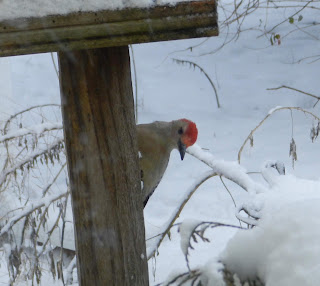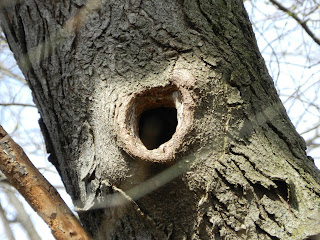 Here in west central Illinois we've had over two foot of snow in January. In addition, record setting temperature and wind chills. It's a good thing to keep the bird feeder filled.
Here in west central Illinois we've had over two foot of snow in January. In addition, record setting temperature and wind chills. It's a good thing to keep the bird feeder filled.Birds have built in systems to keep them from death during cold weather (at least the ones that stick around our area.) That doesn't mean a nasty bit of weather won't cull out the weak. Keeping a bird feeder filled with sunflower seeds and some corn is helpful in keeping their internal heat and strength high. Especially since many berries and weed seeds are covered in snow and ice. And placing a feeder outside a window where you can routinely observe it makes it all the more nice.
And observing I've done. Some things:
I've many more Northern Cardinals this year - several pairs. They are fat and the first and last at the feeder each day.
There are no robins or Rose-breasted Grosbecks. Both must have got the early message of a severe winter.
Lots of Dark-eyed Juncos but not near as many sparrows and finches.
Have a few Red-bellied Woodpeckers but no Downy or Red-headed.
There are a few European Starlings (curses) and no Black-capped Chickadees. I think it's the first year without Chickadees.
I have only a few very shy nuthatches who will zoom in, grab a seed and are gone in an instant.
About the usual number of Mourning Doves but no Red-winged Blackbirds stuck it out.
And then there's always the entertaining "pecking order" each day. The long billed Red-bellied Woodpecker zooms in and every other bird flies out of his way. If they dilly dally too long, he will turn and peck them.
Next in the big billed group, is the Blue Jay. They're know as thugs but they do accomplish quite a lot for the other birds (as long as he is allowed to feed every time he lands.) The big billed birds will swipe their bills through the seeds, sending them flying so there are plenty for ground feeding. They also whisk away ice and snow which makes it possible for smaller beaked birds to eat.
My husband installed an old disk snow sled below our feeder and it catches much of the spilled seed. It helps keep the surrounding flower bed clean, keeps the spilled food from becoming rotten or water logged and allows another place for feeding.
Once these big boys have their fill of seeds, they pretty much go about something else. Both will take seeds and store them, often a mouth full at a time.
The rest of the birds have pretty good dispositions and manage to belly up to the food bar together. If it gets too crowded, the cardinals win.
The Mourning Doves patiently roost in the trees until enough food has spilled and then they'll fly in for a good hardy eat. They prefer eating on the ground but will also use the old sled.
This area of the yard has many places for the birds to roost or fly to when threatened. Some like to scope out the whole area before venturing over to the feeder while others tend to linger too long and seem to have no idea the tasty mouthful they might be for birds of pray.
In times where there is lots of snow, one of the hawks that typically stay over the fields or near the stream across the road will venture in for easy picking.
This year we've had an eagle over by the stream. It pays to drive leisurely down our road observing nature. Leisurely also means driving slow because the road is totally ice covered or drifting.
A bird will sometimes stand on one foot, then another, keeping one tucked into its feathers to keep it warm even though their feet have the ability to take very cold temperatures.
When roosting, they often turn their head and tuck it under their wings or what looks like hunching their shoulders and the head about disappears into their bodies.
In cold climates, it helps to have dense evergreens. These provide roosting places, shelter from snow and wind and safety from predators. Some will stay in nests but most don't. Although I clean out my bird houses, I've never seen one used during winter.
Leaving old trees is also a great nesting place. Dead trees often have holes where branches have broke off or birds have made shelters. Letting some of the brambles such as multi-floral roses, wild raspberries and gooseberries stay wild provides security and nesting for some birds such as the cardinals.
If you have the room, piling your summer yard waste such as trimmed bushes and trees, pulled annuals (no weeds) and leaves in one spot for years allows not only birds shelter but some of the smaller wild animals. I don't know if you could get by with this in town but out here in the country it is just another way to provide and entreat birds to come to my property.
In very cold weather, birds will fluff their feathers. A bird's body heat warms the air between its feathers. They fluff their feathers to get as much air in their feathers as possible. The more air trapped, the warmer the bird.
So the question is "Do we have to do anything or lots of things for birds or they will die?" The balance of nature does a pretty good job of taking care of them without my help. I probably do more for the birds around my yard by not using pesticides than I do by feeding them sunflower seeds. So why do it? It's a good thing to help them in the winter, especially one so severe as this one. AND, it is a daily joy to watch them.
I do have some children that just might insinuate I have too much time on my hands to have gained this much from observing birds but so be it and thank you for the opportunity!
 |
| This tree is near my feeders. How many birds can you see roosting? It helps to click on the first picture and then page through them if you'd like a bigger look. |







No comments:
Post a Comment